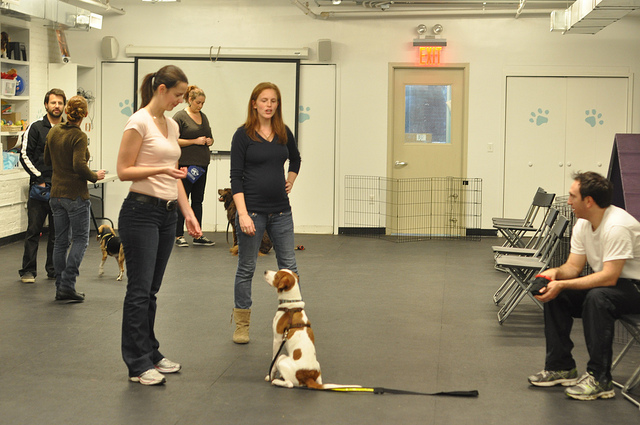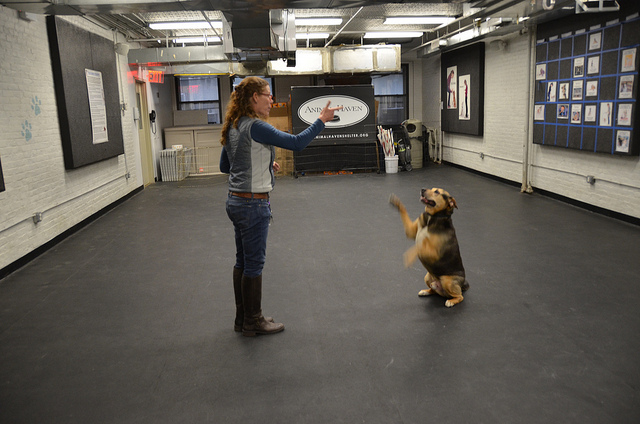Choosing whether you train your dog with verbal or hand signals has always been just that – a personal choice. Most dog trainers have a preferred cuing method that they teach their students. Those wishing to compete in AKC obedience usually choose hand signals, but you will see someone using verbal cues in the ring from time to time. But does one type of signal produce more reliable responses from the dog? A new study set out to answer that exact question.
Related: Best Dog Training Classes You Can Take At Home

Dr. Biagio D’Aniello is a professor in the Biology Department at The University of Naples as well as a dog trainer specializing in water rescue dogs. One day in a class he was teaching, he hurried to help student and distractedly gave his dog the SIT verbal cue while gesturing a DOWN. The dog responded to the gesture cue. It was this small act that made Dr. D’Aniello want to explore the possibility that gestures were a more reliable cue than verbal, he told iHeartDogs.
The Study
To test their hypothesis, the team tested a dog’s reliable responses to verbal and gestural (hand) signals and then try giving a mixed signal (as Dr. D’Aniello did his own dog in the incident above). They chose 25 dogs – Golden Retrievers and Labs – and their handlers from the Italian School of Water Rescue Dogs (SICS) where he works as a trainer. D’Aniello explained they did this because all of the dogs have received the same training using the same methods. In addition all these dogs have been trained to respond to both verbal and hand signals.

To start, they gave each dog a pre-test to ensure they knew all the cues that would be tested, both by hand and verbal. The four cues were: SIT, LIE DOWN, STAY and COME. If they responded to both the hand and the verbal cue for each of these four cues, they continued to the actual tests.
Dr. D’Aniello outlined the 3 phases of the test for us below:
Phase 1 (gestural commands)
The 4 basic commands were delivered using only gestures, without verbal information.
Phase 2 (verbal commands)
The same as phase 1 except that the 4 commands were proposed to dogs using voice only. The person giving commands was asked to take a neutral position with arms hanging down along the body and the head directed forward.
Phase 3 (contrasting commands)
The owner repeated the 4 commands providing incongruent information:
- The vocal command LAY DOWN was associated with the gesture indicating SIT
- The vocal command SIT was associated to the gesture indicating LAY DOWN
- The vocal command COME HERE was associated with the gesture indicating STAY
- The verbal command STAY was associated with the gesture indicating COME HERE. Vocal and gestural commands were given simultaneously.
The Results
D’Aniello explained that in order to evaluate whether the dogs, in general, followed gestural commands over the verbal when given the mixed signals in Phase 3, they computed a “preference index” by calculating for each dog the percentage of gestural commands followed, out of the total commands responded to.
What they found was that dog followed gestures over voice except in the case of the vocal cue COME.
“Interestingly, comparing gestural commands and verbal commands, females were more likely to respond properly to gestural than vocal commands, whereas males did not show any preference,” D’Aniello added.
The “Come” Cue
Why does he think COME had different results than the other signals? It could be due to body language he says:
Our data suggest that, when dogs are equally accustomed to responding to visual and verbal commands, gestural cues are dominant; this supports the evidence that body language plays a major role, being the most important communication channel for dogs. However, dogs’ responses are also dependent on contextual information, since in the case of the vocal command COME dogs not showed a clear preference for the gesture. The verbal command ‘‘COME’’ was paired with the gestural command ‘‘STAY’’ and the owner moved away from the dog. Maybe in the latter case the dog’s responses could have been influenced by the movement of the owner towards another position, which could have activate the motivation to maintain proximity with the owner.
If the owner had said COME, but gestured STAY and did not move, would the dog have come or stayed? It’s an interesting thought, especially since for the other cues they were careful to not include any body movements.
Future Studies
Of course, there are many factors that one could use to question the results of this research. For example, we asked D’Aniello if they thought breed of dog would make a difference in the study. He replied:
This is a point that will be dealt in the future. In fact in the scientific literature, we only have 2 Border Collies that have been tested with conflicting commands and have followed the words. But it must be said that these dogs were trained specifically to words. I recently tested two Border Collies with obedience training and they chose the gesture, but there is need of a bigger sample size.
Dr. D’Aniello went on to explain that body language is very important to a dog, much more so than our language, which he hardly understands. They use body language to communicate with each other and us. And, as humans, we use body language when we communicate with other humans as well (he pointed out that in the Italian culture especially, they “talk” using their hands). So it only makes sense to use our bodies when “speaking” with our dogs.
They have also found, in newer studies, that a dog who chose the gesture of the verbal cue most of the time with their owner did so 100 percent of the time with a stranger. Meaning a stranger’s verbal cue mean nothing to the dog.
The study is not meant to say that verbal cues are “wrong” or that there is not a use for them, especially for long distance training, Dr. Aniello explained to iHeartDogs. Instead, the study was meant to highlight how effective gestural cues can by and remind us that dogs are paying attention to our body language, even more than you may have realized.
For futures studies, Dr. D’Aniello and his team are trying to study rescue dogs, but the sample size is still too small to get results. Their current paper will be published in an upcoming publication of Animal Cognition.
 Toledo, United States.
Toledo, United States.